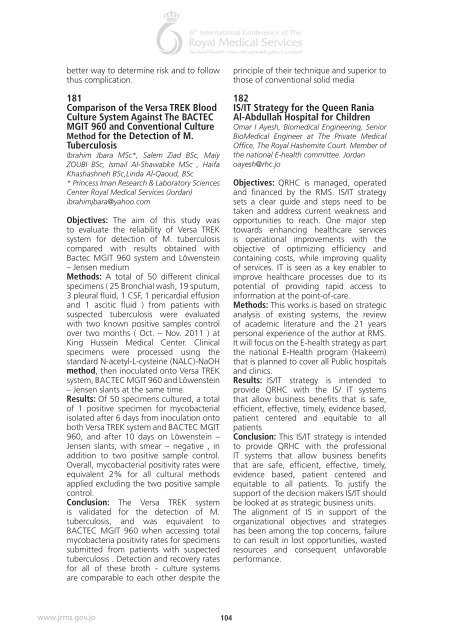Abstract book 6th RMS 16.indd
Abstract book 6th RMS 16.indd
Abstract book 6th RMS 16.indd
Create successful ePaper yourself
Turn your PDF publications into a flip-book with our unique Google optimized e-Paper software.
etter way to determine risk and to follow<br />
thus complication.<br />
181<br />
Comparison of the Versa TREK Blood<br />
Culture System Against The BACTEC<br />
MGIT 960 and Conventional Culture<br />
Method for the Detection of M.<br />
Tuberculosis<br />
Ibrahim Jbara MSc*, Salem Ziad BSc, Maiy<br />
ZOUBI BSc, Ismail Al-Shawabke MSc , Haifa<br />
Khashashneh BSc,Linda Al-Qaoud, BSc<br />
* Princess Iman Research & Laboratory Sciences<br />
Center Royal Medical Services (Jordan)<br />
ibrahimjbara@yahoo.com<br />
Objectives: The aim of this study was<br />
to evaluate the reliability of Versa TREK<br />
system for detection of M. tuberculosis<br />
compared with results obtained with<br />
Bactec MGIT 960 system and Löwenstein<br />
– Jensen medium<br />
Methods: A total of 50 different clinical<br />
specimens ( 25 Bronchial wash, 19 sputum,<br />
3 pleural fluid, 1 CSF, 1 pericardial effusion<br />
and 1 ascitic fluid ) from patients with<br />
suspected tuberculosis were evaluated<br />
with two known positive samples control<br />
over two months ( Oct. – Nov. 2011 ) at<br />
King Hussein Medical Center. Clinical<br />
specimens were processed using the<br />
standard N-acetyl-L-cysteine (NALC)-NaOH<br />
method, then inoculated onto Versa TREK<br />
system, BACTEC MGIT 960 and Löwenstein<br />
– Jensen slants at the same time.<br />
Results: Of 50 specimens cultured, a total<br />
of 1 positive specimen for mycobacterial<br />
isolated after 6 days from inoculation onto<br />
both Versa TREK system and BACTEC MGIT<br />
960, and after 10 days on Löwenstein –<br />
Jensen slants, with smear – negative , in<br />
addition to two positive sample control.<br />
Overall, mycobacterial positivity rates were<br />
equivalent 2% for all cultural methods<br />
applied excluding the two positive sample<br />
control.<br />
Conclusion: The Versa TREK system<br />
is validated for the detection of M.<br />
tuberculosis, and was equivalent to<br />
BACTEC MGIT 960 when accessing total<br />
mycobacteria positivity rates for specimens<br />
submitted from patients with suspected<br />
tuberculosis . Detection and recovery rates<br />
for all of these broth - culture systems<br />
are comparable to each other despite the<br />
principle of their technique and superior to<br />
those of conventional solid media<br />
182<br />
IS/IT Strategy for the Queen Rania<br />
Al-Abdullah Hospital for Children<br />
Omar I Ayesh, Biomedical Engineering, Senior<br />
BioMedical Engineer at The Private Medical<br />
Office, The Royal Hashemite Court. Member of<br />
the national E-health committee. Jordan<br />
oayesh@rhc.jo<br />
Objectives: QRHC is managed, operated<br />
and financed by the <strong>RMS</strong>. IS/IT strategy<br />
sets a clear guide and steps need to be<br />
taken and address current weakness and<br />
opportunities to reach. One major step<br />
towards enhancing healthcare services<br />
is operational improvements with the<br />
objective of optimizing efficiency and<br />
containing costs, while improving quality<br />
of services. IT is seen as a key enabler to<br />
improve healthcare processes due to its<br />
potential of providing rapid access to<br />
information at the point-of-care.<br />
Methods: This works is based on strategic<br />
analysis of existing systems, the review<br />
of academic literature and the 21 years<br />
personal experience of the author at <strong>RMS</strong>.<br />
It will focus on the E-health strategy as part<br />
the national E-Health program (Hakeem)<br />
that is planned to cover all Public hospitals<br />
and clinics.<br />
Results: IS/IT strategy is intended to<br />
provide QRHC with the IS/ IT systems<br />
that allow business benefits that is safe,<br />
efficient, effective, timely, evidence based,<br />
patient centered and equitable to all<br />
patients<br />
Conclusion: This IS/IT strategy is intended<br />
to provide QRHC with the professional<br />
IT systems that allow business benefits<br />
that are safe, efficient, effective, timely,<br />
evidence based, patient centered and<br />
equitable to all patients. To justify the<br />
support of the decision makers IS/IT should<br />
be looked at as strategic business units.<br />
The alignment of IS in support of the<br />
organizational objectives and strategies<br />
has been among the top concerns, failure<br />
to can result in lost opportunities, wasted<br />
resources and consequent unfavorable<br />
performance.<br />
www.jrms.gov.jo<br />
104

















